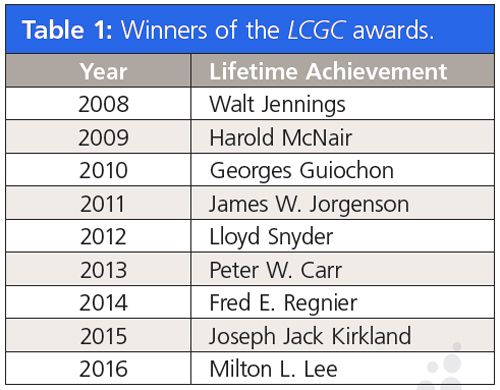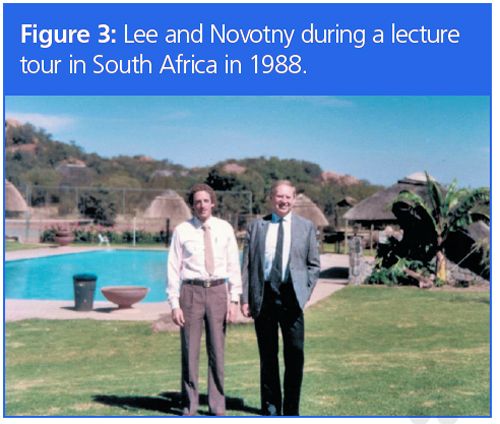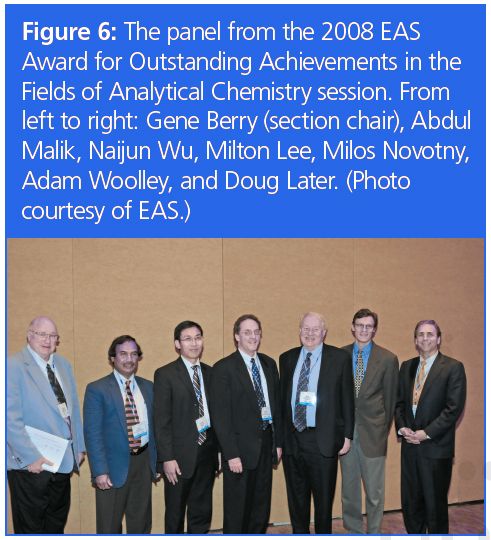The 2016 LCGC Awards: Part 1
This year, LCGC North America is pleased to honour Milton L. Lee, the winner of the 2016 Lifetime Achievement in Chromatography Award.
Meg L’Heureux, LCGC North America
The LCGC Awards have made their mark in chromatography history during the last eight years by honouring the work of iconic figures in the field as well as up-and-coming scientists (Table 1). In 2015, we had the opportunity to go a step further by honouring the award winners at an oral symposium as part of the Pittcon 2015 technical programme, featuring talks by both of the award winners and Mark R. Schure, Lloyd R. Snyder, and Terry A. Berger. The winners of the ninth annual LCGC awards were also honoured at Pittcon 2016. This year, LCGC North America is pleased to honour Milton L. Lee, the winner of the 2016 Lifetime Achievement in Chromatography Award.
Milton L. Lee graduated from the University of Utah in 1971 with a B.A. in chemistry. From there, he went on to receive his Ph.D. in analytical chemistry in 1975 from Indiana University under the guidance of Milos V. Novotny.

“I have been very fortunate to have many great graduate and postdoctoral students during my career,” said Novotny, now a Distinguished Professor Emeritus at Indiana University. “Milton was one of the best.” He was also Novotny’s first. Novotny explained that the two began their work together on several aspects of capillary chromatography and that Lee was “enormously helpful” in starting his research laboratory. Lee was also able to get his PhD in four years with a high number of publications, Novotny noted. “This was because he rapidly learned the experimental skills and knowledge of chromatography and became incredibly motivated and organized in his research,” said Novotny.
After receiving his Ph.D., Lee briefly worked as a chemical engineering research associate at the Massachusetts Institute of Technology under Ronald A. Hites. In 1976, he took an assistant professor position in the Department of Chemistry and Biochemistry at Brigham Young University (BYU) in Provo, Utah, a position he held until 1981. Lee was an associate professor at BYU from 1981 to 1984, and then in 1984 he became a full professor. In 1985, Lee was named the H. Tracy Hall Professor of Chemistry at BYU, which is his current position.

Lee: A Scientist in Motion: Lee is known for a wide range of achievements. In addition to his research and teaching at BYU and his work advancing capillary chromatography, electrophoresis, and other techniques, Lee obtained 20 patents and successfully commercialized three instruments. He also founded three analytical instrument companies (Lee Scientific, Sensar, and Torion) as well as one journal (Journal of Microcolumn Separations). In addition, he has published more than 570 journal articles and given more than 500 presentations.
We interviewed several of Lee’s colleagues, friends, and former students about his achievements, impact, and relationships. One common theme was that Lee’s abilities and work have been wideâranging, making it difficult to name a single greatest contribution to the field.
“When you look back on Lee’s body of work in separations, he has continued to transform himself and his expertise,” said Mary Ellen P. McNally, a Technical Fellow at Dupont Crop Protection. She explained that Lee’s work focused on a wide range of techniques, including supercritical fluid chromatography (SFC), electric field gradient focusing of proteins, high-speed thermal gradient gas chromatography (GC), polymer monolithic column technology for liquid chromatography (LC), sampling and concentration of target organic compounds in air, thermochemolysis–methylation of microorganisms for the generation of characteristic biomarkers, toroidal ion trap mass spectrometry (MS), and fluidic sieving of nanoparticles.
Former graduate school labmate and longâtime friend James Jorgenson, the Kenan Professor of Chemistry at the University of North Carolina at Chapel Hill, agreed. “Lee has worked on so many divergent things, from analyzing tobacco smoke, SFC, and the design of mass spectrometers to monolithic LC columns, and the list goes on and on,” he said.
“He is a giant in separation science with an endless list of accomplishments,” echoed Jim Luong, Associate Technology Director with the The Dow Chemical Company. “What is unique about Milton is that he is a scientist in motion - he continues to invent and to drive science forward!”

Pat Sandra, an Emeritus Professor at the Research Institute for Chromatography, agreed that Lee has significantly contributed to many fields of separation science. “His portable analyzers are definitely some of the highlights of his achievements,” he added.
Theory and Practice: But it is not just Lee’s breadth that is remarkable. It is his ability to connect the diverse areas of his work. Lee’s research philosophy is unique in the way that fundamental chemistry, physics, biology, and mathematics are intertwined with the corresponding applied sciences and technology, noted one of Lee’s postdoctoral researchers, Karin Markides, now the senior advisor to the president and CEO of Chalmers University of Technology. “In this way, theory and practice meet in a most stimulating way to enhance the ability to sample, separate, and detect valuable chemical information,” she said. “His ability to spin out chemical instrumentation of high complexity to the market and at the same time continue as a leading researcher and teacher is an amazing achievement. The impact of his career is too large to measure.”
Former student and colleague Bruce E. Richter, an R&D manager at Agilent Technologies, agreed that Lee is impressive in his ability to connect theory and practice. “While Lee understands the theories, his approach has always been to develop practical solutions for real problems,” he said. “Whether the technique was GC, SFC, LC, or capillary electrophoresis (CE), Lee helped to improve the ability of these techniques to solve real problems by providing new tools and insights that demonstrated higher levels of practicality and usability.”
As an example, Richter cited Lee’s work to develop a better understanding of surface deactivation of fused-silica capillaries and then new and innovative stationary phases all for GC. “Lee has always pushed the envelope of separation science by looking at what problems existed and trying to develop ways of overcoming those problems,” he concluded.

As a result, noted Edward Yeung, a Distinguished Professor Emeritus at Iowa State University, Lee has had a significant impact on separation science. “Lee’s work has not only conceptually changed separation science, but has also had a major influence on the users of separation science,” he said. “This is evident from the many patents that are derived from his work and the different companies that Lee founded to adapt his inventions to practical applications.”
Lee’s influence on instrumentation goes beyond his specific developments, said Markides. “The significance that Lee always gave to the separation part of the analysis and [his insistence] that the column is the most important component of separations instrumentation has strongly influenced the way that instrument companies care for sample separation and transfer to detection,” she said. “This emphasis on separation has been crucial for the successful development of the whole area of microfluidic separations.”
While Lee’s impact in the separations science community has been felt on the industry side, many consider his academic contributions to be his biggest legacy. “Lee spread his knowledge by training around 100 graduate students in his career,” said Pankaj Aggarwal, a senior scientist at Pfizer and a former graduate student of Lee’s.
Another former student of Lee’s, Sheldon Sumpter, who is an operations and program manager at DuPont Crop Protection, agreed with Aggarwal. “Lee’s greatest contributions to the field of separation science are his graduate students and post docs,” he said.

Luong also mentioned Lee’s contributions in academia. “Lee is an incredible educator and a lifelong learner himself,” he said.
Jorgenson agreed. “I suppose in the end, as with many people working in universities, Lee’s greatest contribution will be all of the students he has introduced to the field of separations,” he said.
In the Broader Community: Lee has also been very active with analytical chemistry journals. In addition to founding and editing the Journal of Microcolumn Separations, Lee has been on the editorial advisory boards of 12 different publications at various times during his career. Some of those include Chromatographia (1981–2006), LCGC (1985–1987), Journal of Supercritical Fluids (1988–1999), Polycyclic Aromatic Compounds (1989–2002), Analytical and Bioanalytical Chemistry (1999–2003), and Analytical Methods (2012–present).
In addition, Lee has been involved with several scientific organizing committees over the years. From 1983 to present, Lee has been on the scientific organizing committee for the International Symposia on Capillary Chromatography. Lee was also on the scientific organizing committee for the International Symposia on Microcolumn Separations from 1987 to 1990, and the chairman of the organizing committee for the International Symposia on Supercritical Fluid Chromatography from 1987 to 1991. Finally, Lee was the chairman of the organizing committee for the International Symposia on Capillary Chromatography and Electrophoresis from 1995 to 2005. Lee is currently on the International Advisory Board of Mediterranean Separations Science Foundation Research and Training Center, which he joined in 2005.

Numerous Awards: Over the course of his illustrious career, Lee has been the recipient of 35 awards. Some of those awards include the First Annual Governor’s Medal for Science and Technology, State of Utah (1987); the American Chemical Society (ACS) Award in Chromatography (1988); the Russian Tswett Chromatography Medal (1992); the Martin Gold Medal (1996); the Karl D. Maeser Distinguished Faculty Lecturer Award, BYU (1998); the Dal Nogare Award (1999); The California Separation Science Society (CASSS) Award for Distinguished Contributions to Separation Science (2005); the Pittsburgh Analytical Chemistry Award (2008); and the LCGC Europe Lifetime Achievement Award (2014).
A Teacher’s Legacy: As indicated earlier, Lee has played a significant role in the lives of a large number of students who have gone on to achieve great success in analytical chemistry and related fields. To date, Lee has mentored 62 PhD students, 26 post-doctoral researchers, and eight MS students.
Markides said that Lee inspired his students, partly through his own passion to advance separation science. “Lee’s ability to continuously foster the forefront of basic and applied research mixed with a unique ability and interest to make students understand and strive for more knowledge is a true gift,” she said.
Former PhD student Iuliana M. Lazar, an Associate Professor at Virginia Tech, echoed Markides’s sentiments. Lazar said that Lee had a relentless commitment to science and was extremely creative in providing solutions to difficult problems. “His patience, wisdom, and vision, were - and will continue to be - a source of inspiration throughout my entire career.”
Aggarwal agreed. “The one statement from him that always kept me going was: The feeling you get upon discovering something new cannot be described in words,” he said. “He was absolutely correct about that and I was able to feel the same way while working in his laboratory.”

That excitement of discovery, Lee also taught his students, requires hard work; Lee is described as being meticulous in his pursuit of excellence and asking the same from his students. Richter recalls some late nights working in Lee’s lab with fellow students when they would get a call from Lee to check in. “He wanted to know that we were putting in the time to be successful in our endeavours,” Richter explained. “He taught us that nature does not give up its secrets easily and for those who did not put in the extra work, it would be harder to find the answers.”
Ray West, who was one of Lee’s early graduate students and is now the Director of Business Development at Moxtek, Inc., says he also learned to be a dedicated scientist from Lee “He taught us to work hard and had a cot in the lab so we could be there late in the night taking care of critical experiments,” he recalls. “I don’t think I could have had any better training in graduate school.”
Doug Raynie, an Associate Research Professor at South Dakota State University and another former graduate student of Lee’s, agreed that Lee’s training prepares students to shine once they graduate. When a graduate school labmate went on to work at a leading chromatography supply company, he reported back to his friends that it was the easiest job he ever had. “You develop such a strong work ethic in Lee’s lab that when you go to work you think you’re slacking off, but everyone else is impressed by how hard you’re working,” Raynie told us.
But Lee was not just tough; he was supportive, too. “While Professor Lee set the bar high for his students, he was a very generous and caring supervisor,” said former PhD student Naijun Wu, the Director of Analytical Research and Development at Celgene Corporation.
Wu also mentioned Lee’s dedication to supporting his students at conferences. Wu recalled the 1999 International Symposium on Capillary Chromatography and Electrophoresis, where he was giving a talk as a student in the last session on the last day of the conference. “Prior to the session, Professor Lee asked his other five students attending the conference to show up to my talk,” Wu said. “Without his thoughtful support, I would have been talking to an audience of one,” Wu laughed.
A Generous Friend and Colleague: Lee’s mentorship abilities extend beyond his students. “I am grateful and indebted to Lee for his mentorship and support throughout my career as a scientist,” said Luong, who first met Lee at the International Symposium of Capillary Chromatography in 1995. Lee offered Luong his first opportunity to give a plenary lecture, at the International Symposium of Capillary Chromatography in 1997. “I became a better person and a more successful separation scientist because of mentors like Lee,” he said.
Lee is also a very generous colleague, added Adam Woolley, a professor and the Associate Chair in the Department of Chemistry and Biochemistry at BYU. “Lee has been both generous and instrumental in my career development in terms of helping me get connected with funding sources, securing invitations to present at conferences, and successfully nominating me for various awards,” he said.
Woolley recounted a specific example of Lee’s collegiality. Lee became aware of a call for papers from the National Institutes of Health (NIH) to develop methods to test for bacterial infections. “This wasn’t an area where Lee was actively working, but he knew of several of us here at BYU who would be able to put together a strong proposal, so he got us together,” said Woolley. After the team was assembled, Lee told them his expertise was not needed and suggested they go ahead without him. “Lee was instrumental in helping us secure a five-year, multimillion dollar grant, even though he is not an investigator on it,” Woolley concluded.
Family First: Many friends, colleagues, and past students described Lee as being very family-oriented. “More than once he was offered positions at higher-ranking universities with substantial financial incentives, but he turned them down because moving would mean suddenly putting his family in an unfamiliar place that would require a lengthy adjustment period,” said Yeung.
Markides also felt the effect of Lee’s devotion to family when she was working for him. She explained that one morning before work her oldest son announced that he had to build a wooden car for a Scout competition the next day. Markides and her husband did not know how to get it done in one day, but she went to work because they were very busy in the lab at the time. When she got there, Lee could tell that something was bothering her so she told him about the car her son needed to build. “Lee did the most fantastic thing: he said that we needed to prioritize my son’s car and he called in some professors and graduate students to make a winning construction,” Markides said. “I have referred to this story many times in my life when talking about setting priorities.”
Lee’s family orientation also extended to his students. “As his students, we felt like a big family - Lee would often host birthday parties for students and invite us to his home for Thanksgiving or Christmas,” said Wu. “He also organized group hikes for us in the beautiful areas around Provo.”
Raynie recounted a funny story he heard related to Lee’s family. “Upon hearing his students call him ‘Dr. Lee’, one of his children didn’t believe he was a doctor, so Lee brought them into his lab so they could see him ‘give a shot’ (injection) to a chromatograph,” said Raynie.
In a Few Words: Who Is Milton L. Lee?: The friends, colleagues, and students we interviewed for this article all provided glowing praise for the type of person Lee is and what it is like to work with or for him. This year we also asked everyone to describe Lee’s personal character or work ethic in three words. A few examples of the responses we received include brilliant, innovative, honourable, loyal, curious, dedicated, tireless, and cooperative. The three words that came up most often were: integrity, reliable, and creative.
Novotny expanded on the three words he chose. “Lee has high scientific standards and great organizational skills,” he said “He is a valuable and reliable scientific colleague.”
Richter also said a bit more than just three words about Lee’s personal character and work ethic. “He seems to have unlimited energy and ideas that need developing. He is a man of integrity and loyalty,” said Richter. “He expects a lot from those that work for him, but he also provides an example of someone who is hard-working and dedicated to his field of endeavour.”
Indeed, Lee certainly seems to exemplify a highly creative man with great integrity.
Meg L’Heureux is the Managing Editor of LCGC North America.
E-mail: mlheureux@advanstar.com
Website: www.chromatographyonline.com

Evaluating Body Odor Sampling Phases Prior to Analysis
April 23rd 2025Researchers leveraged the advantages of thermodesorption, followed by comprehensive two-dimensional gas chromatography coupled to time-of-flight mass spectrometry (GC×GC/TOF-MS), to compare and assess a variety of sampling phases for body odor.

.png&w=3840&q=75)

.png&w=3840&q=75)



.png&w=3840&q=75)



.png&w=3840&q=75)











